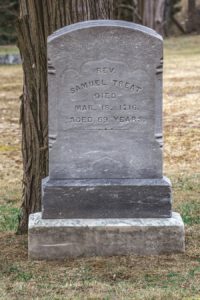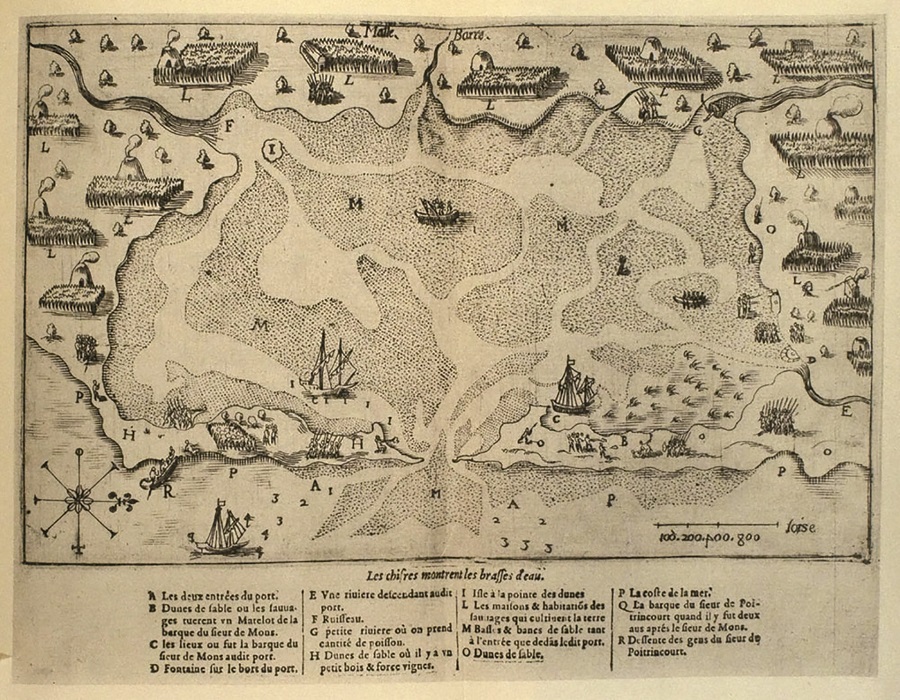Celebrate Samuel Treat Day with the Eastham Public Library on Thursday, March 18th. There will be a Zoom panel discussion, “The Life of Samuel Treat: Pastor for Eastham and the Nauset Praying Indians,” from 10 to 11:30 a.m. Then, from 11:30 a.m. to 2:30 p.m., visit outdoor sites such as the Cove Burying Ground. Finally, join David Silverman for the Zoom talk “When Things Fall Apart: Samuel Treat, the Wampanoags, and the Place of Christian Indians in Colonial New England,” from 3 to 4:30 p.m. Registration is free at easthamlibrary.org.
Samuel Treat Day
GRAVEYARD SHIFT
Eastham Looks Back at Its First Preacher
Samuel Treat Day will ask ‘emotional questions posed by our history’
EASTHAM — The grave marker in the Cove Burying Ground is plain: “Rev. Samuel Treat died Mar. 18, 1716, aged 69 years,” it reads. But the story of Eastham’s first ordained minister, who served as pastor of the Outer Cape’s oldest town for 45 years, is anything but simple.

On March 18, as part of the continuing observance of Eastham 400, the town will recognize the legacy of the Rev. Samuel Treat with a series of online events and self-led actual visits to local sites related to his life here. The day’s events will culminate in a talk by a prominent scholar of Native American history on the indigenous Wampanoag and Nauset people of Outer Cape Cod.
“This day will give local focus to the emotional questions posed by our history,” according to an announcement from the Eastham Public Library, which is sponsoring the observance with Eastham 400. “Were the Mayflower’s Pilgrims dedicated families seeking religious freedom, arriving at an unknown destination, still reeling from a pandemic? Or were they [the first] wave of the European invaders, taking land from Natives and forcing Indian conversions to their English ways of life?”
Born in 1648 into a prominent Connecticut family (his father, Robert Treat, was governor of the colony), Samuel Treat was a 1669 graduate of Harvard College. He began to preach in Eastham in 1672 and was ordained in 1675.
To begin to understand the life and work of the Rev. Samuel Treat, a strict Calvinist, it is helpful to understand the doctrine by which he lived: a matrix of attitudes and superstitions quite alien to modern systems of belief and perhaps impossible to reconcile with them.
Four centuries ago, Puritan theology and authority informed every aspect — religious, cultural, and political — of daily life. Individuals were deemed inherently sinful, but they could have their souls saved by being in a covenant relationship with God that involved a profound examination of one’s faith. This binding agreement with God and his “elected” was proof of the divine right of Puritans to settle the lands of the New World, where, in 1630, they began arriving by the thousands from England during a time of religious turmoil. Divine right, in turn, justified the frontier wars of the 17th century.
Agents of Satan
Despite a deep faith in God and a rigid, disciplined adherence to Scripture, 17th-century daily life was fraught with anxieties, insecurities, and uncertainties, not the least of which was the constant search for signs of God’s favor — or disapproval. Many anxieties were quite real: beasts, scarcity, pest infestations, and drought. Others were perceived, including those “prodigious spirits” that lurked in the vast wildernesses that separated swaths of cultivated land. Those wildernesses, Satan’s domain, were understood to be the abode of a mysterious race of men — Indians — whom colonists saw as hostile and feared as agents of Satan.
For Puritans, God may have been ruling the universe, but he was in a cosmic struggle with the omnipresent Satan for control of the human soul. Ministers, who played a central role in their communities as transmitters of God’s word, did little to allay the fears of their flocks. Rather, they stoked the wilds of the imagination and instilled terror with thundering fire-and-brimstone jeremiads from the pulpit, warning of God’s wrath as well as Satan’s temptations, supernatural powers, and diabolical skills, thereby maintaining community solidarity and spiritual conformity. The Rev. Mr. Treat was every bit a product of the Puritan century and a man of his generation.
Eastham, originally known as Nauset, was settled in 1644 by seven families who had removed from Plymouth. The township, then 15 miles long, included the area to the north, set off as Wellfleet in 1762, and the area to the south, set off as Orleans in 1797.
“For half a century after its founding,” wrote Donald Trayser in his 1951 history of the town, “Eastham was the only town on Cape Cod east of Yarmouth…. Francis Baylies called Eastham the ‘common mother of all towns below Yarmouth.’ Old Eastham unquestionably was mother to Wellfleet and Orleans. And foster mother at least to Truro, Chatham, and Harwich-Brewster.”
Though the small number of original settlers could not support the services of an ordained minister, the Rev. John Mayo went from Barnstable to Eastham in 1646, perhaps in the capacity of a teaching elder, to minister until 1655. During that time, the first meetinghouse was built, and the burial ground (now Cove Burying Ground) was laid out adjacent to it.
Treat arrived in Eastham as a 24-year-old graduate of Harvard, founded by Puritans in 1636 to provide a learned ministry to the colonies. As zealous promoters of education, the Puritans believed that the ability to read would thwart Satan’s efforts to keep people from the Bible, their ignorance of Scripture making them susceptible to his temptations.
Compensated handsomely with a salary, parcels of upland, marsh, and meadow, as well as a woodpile to heat the home the townspeople built for him at Fort Hill, Treat was tireless in his mission to grow his congregation and spread the Gospel. In 1674 he married Elizabeth Mayo, the daughter of John Mayo. They had 11 children. After her death in 1696, Treat married the widow Abigail Easterbrook, daughter of the Rev. Samuel Willard of Boston, and they had two more children. At a time when the population of Eastham was expanding to outlying areas, making it more and more difficult to hold his single church together, Treat’s ministry lasted a remarkable 45 years, to the moment of his death during the Great Snow of 1717, a historic storm.
His voice, and the manner of his delivery, was said to be so loud and ungraceful that it “could be heard at a great distance from the meeting-house, even amidst the shrieks of hysterical women, and the winds that howled over the plains of Nauset.” But Eastham history remembers Treat fondly for his otherwise mild and cheerful manner, his piety and earnestness, and a compassion that endeared him to his flock, including the many Nauset people whom he Christianized.
Preaching to the Natives
He was among a group of Puritan missionaries, perhaps the most prominent being John Eliot at Roxbury and Thomas Mayhew at Martha’s Vineyard, who recognized that language was the chief barrier to preaching the Gospel among natives. Having mastered the spoken language of the Nausets, Treat encouraged literacy by preparing alphabets, grammar books, and translations of the Bible and other theological works.

When Treat himself was not preaching to his converts in their villages, his “pupils” served as teachers, ministering to their congregations using sermons prepared by Treat. The conversion of Natives to “Praying Indians” was central to a godly society, the fulfillment of the Puritan utopian theocracy envisioned by the Great Migration of Congregationalists led by John Winthrop in 1630.
By the time of Treat’s death in 1717, change was already in the air. Puritanism, or at least its fervor, was in decline. Dissident religious groups had begun to proliferate, challenging religious authority and undermining community solidarity. The worldview was radically reoriented during the Age of Reason known as the Enlightenment. The blazing star in the night sky or the drought that ruined crops, once explained as the diabolical work of Satan, could now be understood by science.
Samuel Treat Day in Eastham on the 304th anniversary of his death will begin at 10 a.m. with a panel presentation by Patty Donohoe of the Eastham Historical Society, Ron Petersen of the Orleans Historical Commission, Tom Ryan of Eastham 400, and journalist Bob Seay. Visits to outdoor sites will follow. At 3 p.m., Prof. David Silverman will speak on the topic “When Things Fall Apart: Samuel Treat, the Wampanoags, and the Place of Christian Indians in Colonial New England.”
For more information and to register for Zoom events, visit easthamlibrary.org/400.asp.
